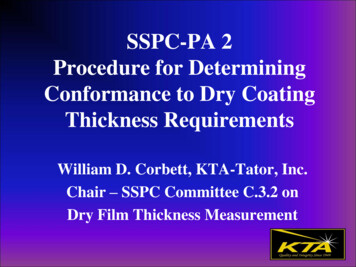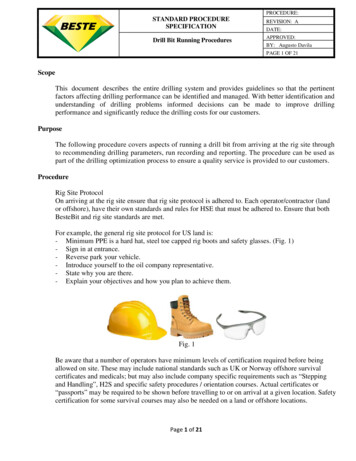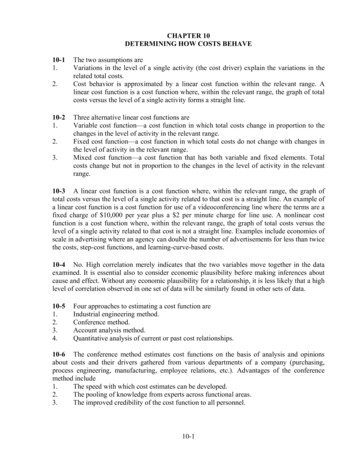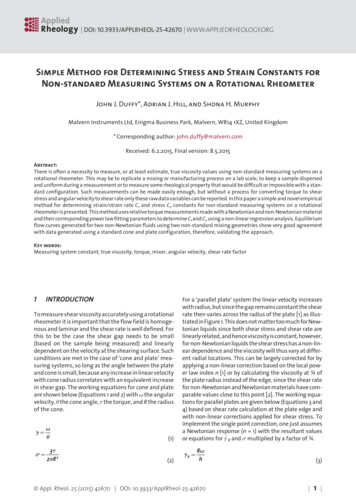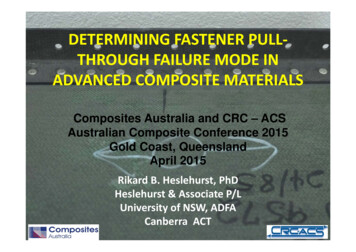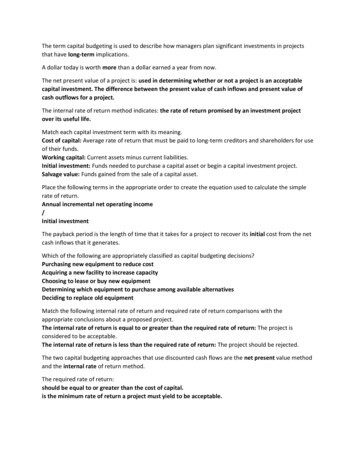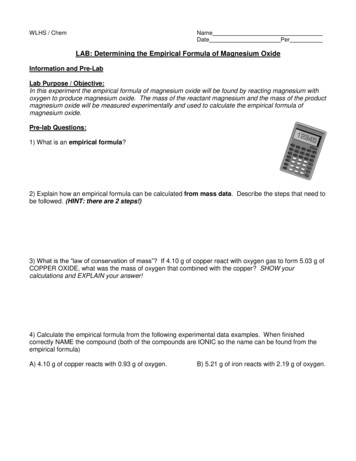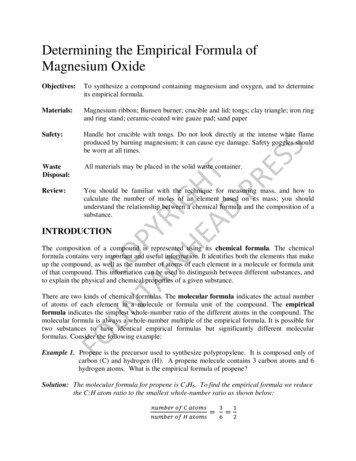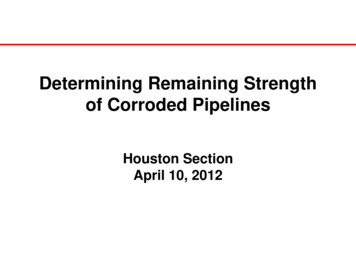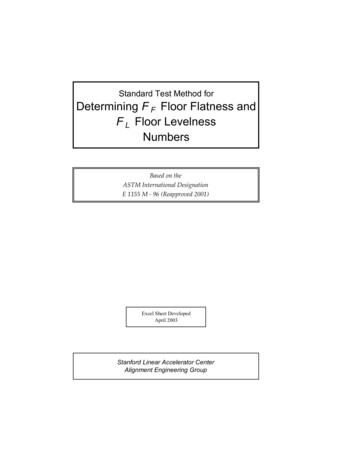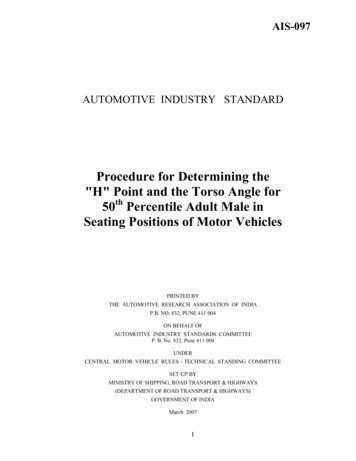
Transcription
AIS-097AUTOMOTIVE INDUSTRY STANDARDProcedure for Determining the"H" Point and the Torso Angle for50th Percentile Adult Male inSeating Positions of Motor VehiclesPRINTED BYTHE AUTOMOTIVE RESEARCH ASSOCIATION OF INDIAP.B. NO. 832, PUNE 411 004ON BEHALF OFAUTOMOTIVE INDUSTRY STANDARDS COMMITTEEP. B. No. 832, Pune 411 004UNDERCENTRAL MOTOR VEHICLE RULES – TECHNICAL STANDING COMMITTEESET-UP BYMINISTRY OF SHIPPING, ROAD TRANSPORT & HIGHWAYS(DEPARTMENT OF ROAD TRANSPORT & HIGHWAYS)GOVERNMENT OF INDIAMarch 2007I
AIS-097Status chart of the Standard to be used by the purchaserfor updating the recordSr.No.CorrigendaAmendmentRevisionDateGeneral remarks:IIRemarkMisc.
AIS-097INTRODUCTIONThe Government of India felt the need for a permanent agency to expedite thepublication of standards and development of test facilities in parallel when thework on the preparation of the standards is going on, as the development ofimproved safety critical parts can be undertaken only after the publication of thestandard and commissioning of test facilities. To this end, the erstwhile Ministryof Surface Transport (MOST) has constituted a permanent Automotive IndustryStandards Committee (AISC) vide order No. RT-11028/11/97-MVL datedSeptember 15, 1997. The standards prepared by AISC will be approved by thepermanent CMVR Technical Standing Committee (CTSC). After approval, theAutomotive Research Association of India, (ARAI), Pune, being the Secretariat ofthe AIS Committee, has published this standard.Based on deliberations in the CMVR-TSC and AISC it has been decided to createa suite of standards related to Passive Safety which are founded on dynamic(or crash) testing of passenger cars and utility vehicles. These standards wouldthen form the basis of the notification and implementation of advanced passivesafety norms in the latter part of this decade as per the Safety Road Map adoptedfor India.The determination of “H point” of seating position in vehicles under considerationis an important part of conducting the dynamic tests envisaged in this suite ofstandards. Accordingly, the existing national standard IS 13749:1993 is beingrevised and aligned with European practice.Towards this the necessary assistance has been taken from the National andInternational standards such as ECE regulations, EEC Directives, SAE, ISO andIndian Standards, list of which is given below.This standard is primarily directed towards providing dimensions for the50th percentile 3 DH-machine as most of the references from other standards arefor this anthropometry. Further requirements for deriving 95th percentileanthropometry from this machine have also been provided as an additionalresource.Finally, an attempt has been made from other non-mandated resources to provideadditional recommendatory dimensions and weights for the 3D H-machine. Thiswill help engineers working in the area of safety to construct such machines.1.2.EEC Directive77/649/EEC(last amended by90/630/EEC)Field of vision of motor vehicle driversEEC Directive74/60/EEC(last amended by2000/4/EC)Motor vehicles interior fittingsAnnex III: Procedure for determining the “H” pointand the actual torso angle for seating positions inmotor vehicles.Annex IV: Procedure for determining the H-pointand actual seat-back angle and for verifying therelative positions of the R and H points and therelationship between the design seat-back angle andthe actual seat back angle.III
AIS-0973.ECE R12(Revision 3 –Amendment 3, 2002)Uniform provisions concerning the approval ofvehicles with regard to the protection of the driveragainst the steering mechanism in the event ofimpact.Annex 6: Procedure for determining the H point andthe actual torso angle for seating positions in motorvehicles.4.ECE R32(Revision 1, 1999)Uniform provisions concerning the approval ofvehicles with regard to the behavior of the structureof the impacted vehicle in a rear end collision.Annex 3: Procedure for determining the H point andthe actual torso angle for seating positions in motorvehicles.5.ECE R33(Revision 1 –Amendment 1, 2000)Uniform provisions concerning the approval ofvehicles with regard to the behavior of the structureof the impacted vehicle in a head-on collision.Annex 3: Procedure for determining the H point andthe actual torso angle for seating positions in motorvehicles6.ECE R 94(Revision 1 –Amendment 4, 2003)7.ECE R 95(Revision 1 –Amendment 4, 2005)Uniform provisions concerning the approval ofvehicles with regard to the protection of theoccupants in the event of a frontal collision.Annex 6: Procedure for determining the H point andthe actual torso angle for seating positions in motorvehiclesUniform provisions concerning the approval ofvehicles with regard to the protection of theoccupants in the event of a lateral collision.8.SAE J826JUN 2002Annex 3: Procedure for determining the H point andthe actual torso angle for seating positions in motorvehiclesH-point machine and design tool procedures andspecifications9.ISO 6549:1980Road Vehicles – Procedure for H-pointdetermination”The Automotive Industry Standards Committee (AISC) responsible forpreparation of this standard is given in Annex : 5IV
AIS-097Procedure for Determining the "H" Point and theTorso Angle for 50th Percentile Adult Male inSeating Positions of Motor Vehicles0.SCOPE0.1The procedure described is used to establish the "H" point location and thetorso angle for one or several seating positions in a motor vehicle fora 50th percentile adult male and to verify the relationship of measured datato design specifications given by the vehicle manufacturer(1).0.2A vehicle complying with the requirements of IS 13749 is deemed to meetthe requirements of this standard1.REFERENCES1.1IS:13749 - 1993 : Automotive Vehicles – Determination of H pointMethod of Test2.DEFINITIONS2.1“Reference data" means one or several of the following characteristics ofa seating position:2.1.1. the "H" point and the "R" point and their relationship,2.1.2. the measured torso angle and the design torso angle and their relationship.2.2."Three-dimensional 'H' point machine" (3 DH machine) means thedevice used for the determination of "H" points and torso angles.This device is described in Annex 1.2.3.“H point" means the pivot centre of the torso and thigh of the3 DH machine installed in the vehicle seat in accordance withParagraph 4 below. The "H" point is located in the centre of the centrelineof the device which is between the "H" point sight buttons on either side ofthe 3 DH machine. The "H" point corresponds theoretically to the"R" point (for tolerances see item 3.2.2 below). Once determined inaccordance with the procedure described in Paragraph 4, the "H" point isconsidered fixed in relation to the seat-cushion structure and to move withit when the seat is adjusted;2.4.'R' point", or "seating reference point" means a design point defined bythe vehicle manufacturer for each seating position and established withrespect to the three-dimensional reference system;2.5."Torso-line" means the centreline of the probe of the 3 DH machine withthe probe in the fully rearward position;(1) In any seating position other than front seats where the "H" point cannot be determined usingthe "Three- dimensional 'H' point machine" or procedures, the "R" point indicated by themanufacturer may be taken as a reference at the discretion of the competent authority.1/14
AIS-0972.6."Torso angle" means the angle measured between a vertical line throughthe "H" point and the torso line using the back angle quadrant on the3 DH machine. The torso angle corresponds theoretically to the designtorso angle (for tolerances see item 3.2.2 below);2.7.“Design torso angle" means the angle measured between a vertical linethrough the "R" point and the torso line in a position which corresponds tothe design position of the seat-back established by the vehiclemanufacturer;2.8."Centreplane of occupant" (C/LO) means the median plane of the3 DH machine positioned in each designated seating position; it isrepresented by the co-ordinate of the "H" point on the "Y" axis. Forindividual seats, the centreplane of the seat coincides with the centreplaneof the occupant. For other seats, the centreplane of the occupant isspecified by the manufacturer;2.9."Three dimensional reference system" means a system as described inAnnex 2.2.10. "Fiducial marks" are physical points (holes, surfaces, marks orindentations) on the vehicle body as defined by the manufacturer;2.11. “Vehicle measuring attitude" means the position of the vehicle asdefined by the co-ordinates of fiducial marks in the three-dimensionalreference system.3.REQUIREMENTS3.1.Data presentationFor each seating position where reference data are required in order todemonstrate compliance with the provisions of the present Directive, all oran appropriate selection of the following data shall be presented in theform indicated in Annex 3.3.1.1. the coordinates of the "R" point relative to the three-dimensional referencesystem;3.1.2. the design torso angle;3.1.3. all indications necessary to adjust the seat (if it is adjustable) to themeasuring position set out in item 4.3 below.3.2.Relationship between measured data and design specifications3.2.1. The coordinates of the "H" point and the value of the torso angle obtainedby the procedure set out in item 4 below shall be compared, respectively,with the coordinates of the "R" point and the value of the design torsoangle indicated by the vehicle manufacturer.2/14
AIS-0973.2.2. The relative positions of the "R" point and the "H" point and therelationship between the design torso angle and the torso angle shall beconsidered satisfactory for the seating position in question if the "H" point,as defined by its coordinates, lies within a square of 50 mm side lengthwith horizontal and vertical sides whose diagonals intersect at the"R" point, and if the torso angle is within 5 of the design torso angle.3.2.3. If these conditions are met, the "R" point and the design torso angle shallbe used to demonstrate compliance with the provisions of this standard.3.2.4. If the "H" point or the torso angle does not satisfy the requirements of item3.2.2 above, the "H" point and the torso angle shall be determined twicemore (three times in all). If the results of two of these three operationssatisfy the requirements, the conditions of item 3.2.3 above shall apply.3.2.5. If the results of at least two of the three operations described in item 3.2.4above do not satisfy the requirements of item 3.2.2 above, or if theverification cannot take place because the vehicle manufacturer has failedto supply information regarding the position of the "R" point or regardingthe design torso angle, the centroid of the three measured points or theaverage of the three measured angles shall be used and be regarded asapplicable in all cases where the "R" point or the design torso angle isreferred to in this standard.4.PROCEDURE FORDETERMINATION"H"POINT4.1.The vehicle shall be preconditioned at the manufacturer's discretion, at atemperature of 20 10 C to ensure that the seat material reaches roomtemperature. If the seat to be checked has never been sat upon,a 70 to 80 kg person or device shall sit on the seat twice for one minute toflex the cushion and back. At the manufacturer's request, all seatassemblies shall remain unloaded for a minimum period of 30 minutesprior to installation of the 3 DH machine.4.2.The vehicle shall be at the measuring attitude defined in item 2.11 above.4.3.The seat, if it is adjustable, shall be adjusted first to the rearmost normaldriving or riding position, as indicated by the vehicle manufacturer, takinginto consideration only the longitudinal adjustment of the seat, excludingseat travel used for purposes other than normal driving or riding positions.Where other modes of seat adjustment exist (vertical, angular, seat-back,etc.) these will be then adjusted to the position specified by the vehiclemanufacturer. For suspension seats, the vertical position shall be rigidlyfixed corresponding to a normal driving position as specified by themanufacturer. In the absence of specification of seat back angle by themanufacturer, it shall be adjusted to an angle as near as possible to 25 o.4.4.The area of the seating position contacted by the 3 DH machine shall becovered by a muslin cotton, of sufficient size and appropriate texture,described as a plain cotton fabric having 18.9 threads per cm2 andweighing 0.228 kg/m2 or knitted or non-woven fabric having equivalentcharacteristics.3/14ANDTORSOANGLE
AIS-097If a test is run on a seat outside the vehicle, the floor on which the seat isplaced shall have the same essential characteristics (1) as the floor of thevehicle in which the seat is intended to be used.4.5.Place the seat and back assembly of the 3 DH machine so that thecentreplane of the occupant (C/LO) coincides with the centreplane of the3 DH machine. At the manufacturer's request, the 3 DH machine may bemoved inboard with respect to the C/LO if the 3 DH machine is located sofar outboard that the seat edge will not permit leveling of the3 DH machine.4.6.Attach the foot and lower leg assemblies to the seat pan assembly,either individually or by using the T-bar and lower leg assembly. A linethrough the "H" point sight buttons shall be parallel to the ground andperpendicular to the longitudinal centreplane of the seat.4.7.Adjust the feet and leg positions of the 3 DH machine as follows:4.7.1. Designated seating position: driver and outside front passenger.4.7.1.1. Both feet and leg assemblies shall be moved forward in such a way thatthe feet take up natural positions on the floor, between the operatingpedals if necessary. Where possible the left foot shall be locatedapproximately the same distance to the left of the centreplane of the3 DH machine as the right foot is to the right. The spirit level verifyingthe transverse orientation of the 3 DH machine is brought to thehorizontal by readjustm
2.3. “H point" means the pivot centre of the torso and thigh of the 3 DH machine installed in the vehicle seat in accordance with Paragraph 4 below. The "H" point is located in the centre of the centreline of the device which is between the "H" point sight buttons on either side of the 3 DH machine. The "H" point corresponds theoretically to the "R" point (for tolerances see item 3.2.2 below .
